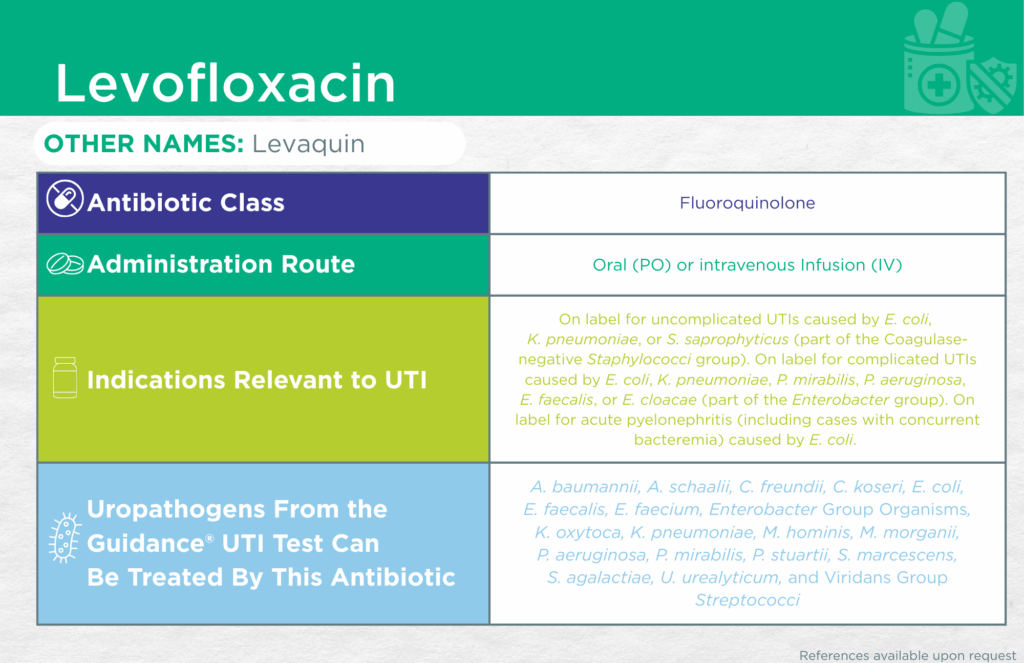Levofloxacin

Emery Haley, PhD, Scientific Writing Specialist
Levofloxacin
Find the Latest FDA-Approved Labelling Information Here: Drugs@FDA Online Database
Administrative Routes
Oral (PO) or Parenteral [intravenous infusion (IV)]
Other Names
Levaquin
Bacteriostatic or Bactericidal
Bactericidal [1]
Antibiotic Class
Fluoroquinolone
Mechanisms of Action
The drug inhibits bacterial DNA topoisomerase IV and DNA-gyrase enzymes, preventing bacterial DNA replication and repair. The bacterial cells accumulate DNA damage which eventually causes bacterial cell death.
WHO AWaRe Classification
Watch [2]
Empiric Use Recommendations
Yes* (preferred for complicated UTI with or without sepsis) [Infectious Diseases Society of America (IDSA)] [3]
*Avoid if used by the patient in the previous 12 months.
Indication(s) Relevant to UTI
On label for uncomplicated UTIs caused by Escherichia coli, Klebsiella pneumoniae, or Staphylococcus saprophyticus (part of the Coagulase-negative Staphylococci group).
On label for complicated UTIs caused by Escherichia coli, Klebsiella pneumoniae, Proteus mirabilis, Pseudomonas aeruginosa, Enterococcus faecalis, or Enterobacter cloacae (part of the Enterobacter group).
On label for acute pyelonephritis (including cases with concurrent bacteremia) caused by Escherichia coli.
Checkmarks
CLSI and/or FDA documents support the efficacy of this antibiotic against the following organisms from the Guidance® UTI test: Acinetobacter baumannii, Citrobacter freundii, Citrobacter koseri, Escherichia coli, Enterococcus faecalis, Enterococcus faecium, Enterobacter Group Organisms, Klebsiella oxytoca, Klebsiella pneumoniae, Mycoplasma hominis, Morganella morganii, Pseudomonas aeruginosa, Proteus mirabilis, Providencia stuartii, Serratia marcescens, Streptococcus agalactiae, Ureaplasma urealyticum, and Viridans Group Streptococci.
Published primary literature supports the efficacy of this antibiotic against the following organism from the Guidance® UTI test: Actinotignum schaalii [4]
- Ishak, A.; Mazonakis, N.; Spernovasilis, N.; Akinosoglou, K.; Tsioutis, C. Bactericidal versus Bacteriostatic Antibacterials: Clinical Significance, Differences and Synergistic Potential in Clinical Practice. J. Antimicrob. Chemother. 2024, 80, 1–17, doi:10.1093/jac/dkae380
- AWaRe Classification of Antibiotics for Evaluation and Monitoring of Use, 2023 Available online: https://www.who.int/publications/i/item/WHO-MHP-HPS-EML-2023.04 (accessed on 6 February 2025).
- Complicated Urinary Tract Infections (CUTI): Clinical Guidelines for Treatment and Management Available online: https://www.idsociety.org/practice-guideline/complicated-urinary-tract-infections/ (accessed on 28 July 2025).
- Cattoir, V.; Varca, A.; Greub, G.; Prod’hom, G.; Legrand, P.; Lienhard, R. In Vitro Susceptibility of Actinobaculum Schaalii to 12 Antimicrobial Agents and Molecular Analysis of Fluoroquinolone Resistance. J Antimicrob Chemoth 2010, 65, 2514–2517, doi:10.1093/jac/dkq383.
Dr. Emery Haley is a scientific writing specialist with over ten years of experience in translational cell and molecular biology. As both a former laboratory scientist and an experienced science communicator, Dr. Haley is passionate about making complex research clear, approachable, and relevant. Their work has been published in over 10 papers and focuses on bridging the gap between the lab and real-world patient care to help drive better health outcomes.